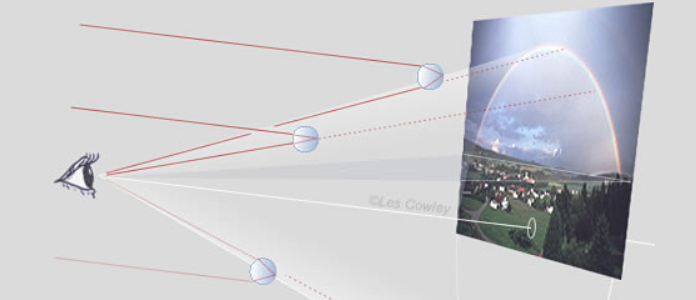Primary Rainbow Cone
Primary Rainbow Cone: Exploring the Phenomenon in Detail
When we gaze up at the sky after a rainfall, we are often treated to the enchanting sight of a rainbow. But have you ever wondered about the science behind this captivating natural phenomenon? In this article, we will delve into the intricacies of the primary rainbow cone, shedding light on its formation and unique characteristics.
The primary rainbow cone is a fundamental element of the primary rainbow. Imagine rays of sunlight passing through countless raindrops in the air. These rays form a cone shape, with its tip positioned at your eye and its axis parallel to the sun's rays, extending downward towards the antisolar point. This cone serves as the conduit through which the primary bow is created.
Within the primary rainbow cone, raindrops near its surface play a crucial role in producing the vibrant colors of the rainbow. Interestingly, the distance between these raindrops and the observer does not impact the appearance of the rainbow. Whether they are just a few feet away or several miles distant, the rainbow retains its characteristic beauty. It is important to note that the rainbow itself is not a physical entity occupying a specific point in space; rather, it is a collection of light rays traveling in specific directions.
While drops inside the primary rainbow cone contribute to the brilliance of the primary bow, drops outside the cone do not send any light into this particular rainbow. However, these drops may be situated on the surface of someone else's rainbow cone. This intriguing phenomenon means that each individual perceives their own unique rainbow cone and observes their personal rendition of the rainbow.
In addition to the primary rainbow cone, there exists another cone associated with the secondary bow. The half angle of this cone is slightly larger than that of the primary cone, measuring 51º compared to the primary's 42º. Remarkably, both cones share the same axis. Droplets situated on the surface of the secondary cone or outside it contribute to the formation of the secondary bow. It is worth noting that drops outside the primary cone but within the secondary cone cannot send any light to the observer, resulting in a dark region known as "Alexander's dark band."
One intriguing aspect of the primary rainbow cone is its apparent fixed position relative to the sun. This becomes evident when observing a rainbow from a moving car or train, where the rainbow remains stationary while the landscape appears to shift. Although each eye technically sees a slightly different rainbow, this discrepancy is only noticeable when the water droplets forming the rainbow are in close proximity, such as those produced by a garden hose.
To further appreciate the beauty and complexity of the primary rainbow cone, let us consider an example. The bow over Schlägl, Austria was beautifully captured by Karl Kaiser, providing us with a larger version to marvel at. This image showcases the magnificence of the primary rainbow cone, reminding us of the wonders that can be observed in our natural surroundings.
In conclusion, the primary rainbow cone serves as a crucial element in the formation of the primary bow. Understanding its characteristics and role in creating rainbows enhances our appreciation for this awe-inspiring phenomenon. Whether we witness a rainbow from a stationary vantage point or through the window of a moving vehicle, the primary rainbow cone continues to captivate our imagination and remind us of the intricate workings of nature.

The Rainbow Cone
Rays of the primary bow form a cone. Its tip is at your eye. Its axis is parallel to the sun's rays and directed downwards to the antisolar point.
Myriad raindrops near the cone's surface send sunlight into your eye to produce the bow. The drops can be a few feet away or a mile or so. Their distance does not matter, the rainbow looks the same. The rainbow is a collection of rays with particular directions, it does not otherwise exist and it is not located at any particular point in space.
Drops inside the cone brighten the sky inside the bow. Drops outside the cone send no light into your primary bow.. But they might be on the surface of someone else's rainbow cone. Each person has their own cone and sees their very own rainbow...
. The secondary bow also has a cone. Its half angle is 51º compared to the primary's 42º. Both cones share the same axis. Droplets on the secondary cone's surface or outside it contribute light to the secondary. Drops outside the primary cone and inside the secondary can send no light to your eye. The resulting dark sky is called "Alexander's dark band".
.. This becomes evident when a rainbow is seen from a car or train, it stays fixed relative to the sun while the landscape appears to move. Strictly speaking each eye sees a different bow but this is only apparent when the water drops forming them are close, from a garden hose for example.
... The bow over Schlägl, Austria was imaged by Karl Kaiser, large version here.
Note: this article has been automatically converted from the old site and may not appear as intended. You can find the original article here.
Reference Atmospheric Optics
If you use any of the definitions, information, or data presented on Atmospheric Optics, please copy the link or reference below to properly credit us as the reference source. Thank you!
-
<a href="https://atoptics.co.uk/blog/primary-rainbow-cone/">Primary Rainbow Cone</a>
-
"Primary Rainbow Cone". Atmospheric Optics. Accessed on December 21, 2024. https://atoptics.co.uk/blog/primary-rainbow-cone/.
-
"Primary Rainbow Cone". Atmospheric Optics, https://atoptics.co.uk/blog/primary-rainbow-cone/. Accessed 21 December, 2024
-
Primary Rainbow Cone. Atmospheric Optics. Retrieved from https://atoptics.co.uk/blog/primary-rainbow-cone/.